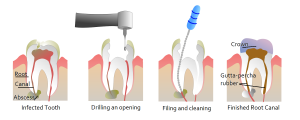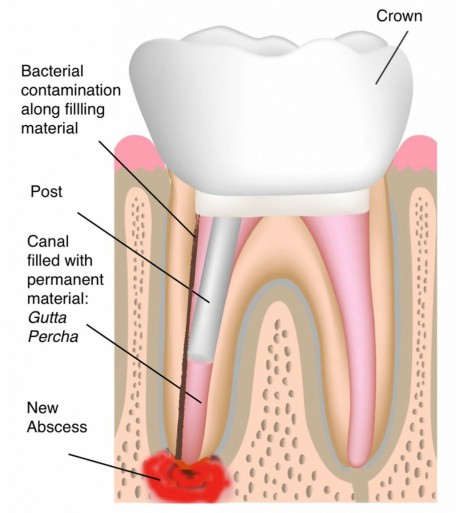Root Canal Treatment
What is Root canal treatment?
Root canal treatment is necessary with decay in your tooth has reached the living pulp of the tooth, the pulp is exposed due to injury or fracture of the tooth or due to some other reason, the pulp if the tooth is no longer vital ( alive). The tooth will often be very sore or may have boils appearing at the base of the tooth.
How is it done?
Treatment often involves a couple of visits to the dentist. During treatment, your dentist removes the diseased pulp. The pulp chamber and root canal(s) of the tooth are then cleaned and sealed.
Here’s how your tooth is saved through treatment:
- First, an opening is made through the crown of the tooth.
2. An opening is made through the crown of the tooth into the pulp chamber.
3. The pulp is then removed. The canal(s) is cleaned and shaped to a form that can be filled.
4. The pulp is removed, and the root canals are cleaned, enlarged and shaped.
5. Medications may be put in the pulp chamber and root canal(s) to help get rid of germs and prevent infection.
6. A temporary filling will be placed in the crown opening to protect the tooth between dental visits. Your dentist may leave the tooth open for a few days to drain. You might also be given medicine to help control infection that may have spread beyond the tooth. This may be done several times to help clear the infection.
7. The pulp chamber and root canals are filled and sealed once the canals are clean and infection cleared and a permanent filling is placed on top.

A: Infected Tooth
B: Drilling an opening
C: Filling and cleaning
D: Finished Root Canal
What is the success rate?
There is an approximate 80% success rate with root canal treatment.
How long does it take?
Root canal treatment is carried out over a series of appointments, each appointment is between 45 – 60 minutes ling and are timed approximately 1-2 weeks apart.
After the root canal treatment
Root canal treatment of a tooth will result in the tooth becoming very brittle after the treatment due to the removal of the pulp. To help preserve this tooth and strengthen it, it is recommended that the tooth should have a crown placed on it after 3-6 months of the root canal completion.
What are the causes of failure in a root canal treatment?
There are many reasons why a root canal treatment may fail including:
1. The tooth breaks between appointments to a point where it cannot be restored
2. Calcified canals
3. Breakage of the small instruments in the tooth canal
4. During the filling of the roots, too much or too little material may be placed
5. Extra canals in the tooth that cannot be seen in regular x rays or may occur deep in the root , out of reach of the dentists instruments Severe gum disease
6. Incomplete or defective restoration
7. Fracture of the tooth after completion
What are the alternatives to a root canal treatment?
The alternative treatment to root canal treatment is to have the tooth removed or extracted.
Complications if a root canal treatment is not done
If left untreated the infected pulp may cause inflammation which also reduces the blood supply to the tooth. The diminished blood supply to the tooth keeps the nerve tissue from recovering and antibiotics may be ineffective here. The infection will need to be manually removed.
The infection can also spread to the bone around the tooth leading to formation of abscess which is a collection of pus due to rapidly multiplying bacteria. As the pus accumulates in the bone the tooth rises in the socket and will be painful on biting down.
If not treated this infection can further spread to surrounding tissues and nerves causing severe swelling, fever, nausea, difficulty in swallowing and breathing.
If you have any questions, please feel free to call us on 0800 268 954 or send an e mail to appointment@hillparkdental.co.nz

